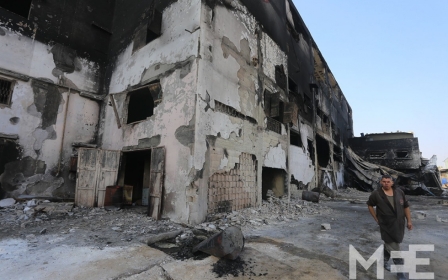Oh empty land, where art thou?

As we all know, the old Zionist canard that Palestine was “a land without people” greatly facilitated the usurpation of said land by the state of Israel.
A new version of this mantra has now been introduced by ex-Harvard Law School professor Alan Dershowitz, who regularly volunteers his expertise in criminal law to defend Israel’s war crimes. Recent efforts include hallucinating a plot by Hamas “to kill and kidnap” 57 Israeli babies and children.
In an article for the Gatestone Institute this month, Dershowitz put forth the theory that the Gaza Strip in fact encompasses a great deal of land without people. Titled “The empty spaces of Gaza”, the article begins:
“How many times have you heard on television or read in the media that the Gaza Strip is ‘the most densely populated area in the world’? Repeating this statement, however, does not make it true.”
This, of course, is a classic case of Dershowitzian projection; after all, repeating a million times that Israel only targets terrorists doesn’t change the fact that it regularly slaughters civilians. Dershowitz invites readers to explore the empty spaces of Gaza: “Just look at Google Earth, or this population density map.”
Never mind that the population density map to which he links comes complete with the explanation that Gaza is “one of the most densely populated tracts of land in the world”.
The three questions
Dershowitz proposes three “important moral questions” regarding the discovery of vast empty space within the diminutive coastal enclave. (Naturally, none of the questions considers the morality of committing genocidal behavior against a trapped population.)
The first question deals with why the media allegedly refuses to show the sparsely inhabited areas of the Gaza Strip, focusing instead on densely populated cities. Part of the answer, Dershowitz surmises, is that “[t]here is no fighting going on in the sparsely populated areas, so showing them would be boring”.
Fighting in them would presumably also be boring, since Israel is not into destroying nothing; it wants to destroy people and things, not empty spaces. And the more space that can be cleared by massive and indiscriminate bombardment, the better for Israel’s territorial and demographic designs.
Another potential answer, according to Dershowitz, is that Hamas doesn’t permit the media to show empty territory. Which brings us to the second moral question: why Hamas allegedly insists on launching rockets and digging tunnels in non-empty spaces.
The answer to this question is more straightforward: lots of people equals lots of human shields equals sadistic happiness for Hamas. But less delusional observers have offered alternate equations. The Independent’s Kim Sengupta, for example, filed a story from Khan Younis in July titled “The myth of Hamas’s human shields”.
In it, he reported a grand total of zero Gaza residents interviewed who claimed to have been forced into human shieldom by the militant group. He also quoted the neighbour of a family that had just lost 24 members in an Israel airstrike on possibilities for avoiding obliteration: “Where do we go to? Some people moved from the outer edge of Khan Younis to Khan Younis centre after Israelis told them to, then the centre got bombed. People have moved from this area to Gaza City, and Gaza City has been bombed.”
Clearly, then, the very inhabitants of Gaza are not aware of the emptiness surrounding them, and would benefit from a Google Earth consultation.
As for Dershowitz’s third question, this one tackles the issue of why the United Nations forces Israel to kill Palestinian civilians by sheltering them “right in the middle of the areas from which Hamas is firing”. This demonstrates the “complicity of UN agencies” in the “cynical game being played by Hamas” to turn global opinion against Israel.
The emptiness within
What we end up with thanks to the Dershowitzian interrogation session is a joint Hamas-media-UN conspiracy to brainwash the world into believing that the Gaza Strip is perhaps a bit cluttered.
The UN’s complicity is particularly clear in its fact sheets about Gaza:
“Stretching about 45km from north to south and only about 5km wide it comprises an area of only 365 km sq. With a population numbering 1.4 million it is one of the most densely populated areas in the world.”
Media collusion has meanwhile been underscored by The Guardian’s recent rejection of an ad penned by Dershowitz on the “empty spaces” theme. The J-Wire website quotes the man’s response:
“The Guardian, which holds itself out to be a purveyor of diverse truth, clearly reflects a bias against Israel on its editorial pages, as well as in its presentation of the news. Now that bias has spread to the advertising pages.”
Of course, were one to propose an ad stating that the moon is made of green cheese, this would presumably be rejected as well - meaning there are commonsense reasons, not just ideological, for refusing to publish nonsense.
But the conversion of institutions that are not at all anti-Israel into veritable accomplices of Hamas is a useful sleight of hand in detracting attention from the real victims of conflict.
Earlier this month, The Guardian happened to run none other than an anti-Hamas advertisement co-written by fanatical Zionist Elie Wiesel, alleging Hamas’s use of children as human shields.
This would seem to confirm that the ubiquitous anti-Israel bias exists entirely within Dershowitz’s brain - which appears to contain many more empty spaces than the Gaza Strip.
- Belen Fernandez is the author of The Imperial Messenger: Thomas Friedman at Work, published by Verso. She is a contributing editor at Jacobin magazine.
The views expressed in this article belong to the author and do not necessarily reflect the editorial policy of Middle East Eye.
New MEE newsletter: Jerusalem Dispatch
Sign up to get the latest insights and analysis on Israel-Palestine, alongside Turkey Unpacked and other MEE newsletters
Middle East Eye delivers independent and unrivalled coverage and analysis of the Middle East, North Africa and beyond. To learn more about republishing this content and the associated fees, please fill out this form. More about MEE can be found here.





